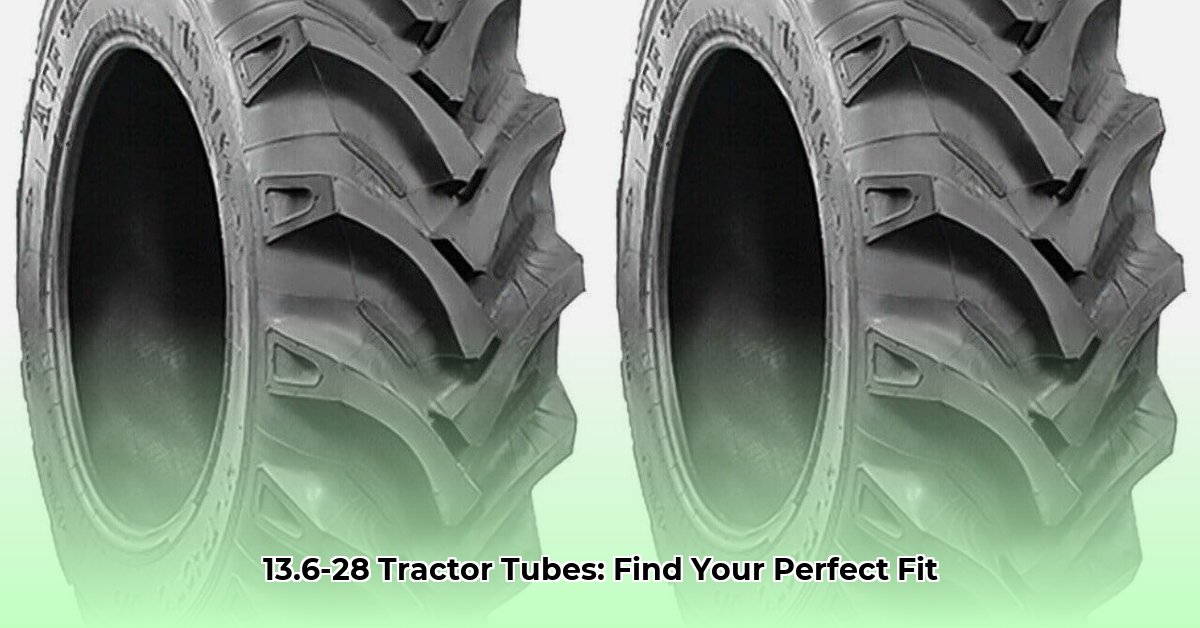
Finding the right inner tube for your 13.6-28 tractor tires is crucial for optimal tire performance, safety, and minimizing downtime. This guide compares different options, highlighting key features and considerations to help you make an informed decision. We'll explore factors beyond just size, emphasizing the importance of proper maintenance and safe practices. For more tire options, check out this helpful resource on tractor tire sizes.
Understanding 13.6-28 Tractor Tubes and Alternatives
The 13.6-28 tire size is common in agriculture, but inner tubes vary significantly in material, construction, and compatibility. A mismatch can lead to premature wear, bursts and potentially dangerous situations. Therefore, understanding your specific needs and the nuances of different tubes is essential for making a cost-effective and reliable choice. This is not simply a matter of buying the cheapest tube; the long-term implications of using an incompatible or low-quality tube can be significant.
Comparing Key Features: Product A vs. Product B
Let's analyze two hypothetical 13.6-28 tractor inner tubes – Product A and Product B – to illustrate the key differences and considerations. Note that specific brand names are omitted for objectivity. Always verify specifications with the manufacturer before purchasing.
Isn't it crucial to understand the subtle differences between these options before making a purchase?
| Feature | Product A | Product B |
|---|---|---|
| Size Compatibility | 13.6-28, 12.4-28 | 13.6-28, 14.9-28, 11.2-28 |
| Material | Butyl Rubber | Natural Rubber |
| Valve Type | TR13 | TR15 |
| Price | $35 | $45 |
| Estimated Life | 3 years (under average use) | 4 years (under average use) |
Product B, while more expensive, offers greater compatibility across various tire sizes. This versatility is valuable for farms with multiple tractors or those using different tire sizes for various tasks. Product A offers a budget-friendly alternative, but its limited compatibility might make it less suitable for diversified operations. The material difference between butyl and natural rubber also factors into durability and longevity, though further research into the specific formulations used in each product would be needed for definitive comparisons. The claim of a longer lifespan for Product B needs further investigation through independent testing; a four-year lifespan may not hold true under strenuous usage.
Essential Considerations for Your Choice
Beyond the direct comparison of Product A and B, several additional factors influence your decision, creating the need for careful consideration and a detailed understanding of your specific farming practices. What is it about your farming operation that would influence the choice of tractor tube?
Tire Size Accuracy: Double-check your tire's exact dimensions. Using an incorrect size is dangerous. The correct fit is paramount to safe and effective operation.
Budget: While higher-priced tubes usually mean better materials and longevity, it's crucial to balance upfront costs with long-term cost-effectiveness. A very cheap tube may fail prematurely, negating any initial savings.
Durability Needs: Intensive agricultural use demands robust tubes. Consider the level of stress your tubes will undergo; factors like soil conditions and terrain can have a considerable impact on tube wear and tear.
Availability: Factor in sourcing ease; readily available tubes minimize downtime if a replacement is needed. A common size may be easier to replace than a less common or specialized size.
Maintenance and Safe Installation Practices
Regular inspections are crucial. Check for cuts, abrasions, and signs of wear; timely detection and repair can significantly extend the tube's life. Always consult your tractor's owner's manual for specific installation instructions and safety guidelines. Remember, improper installation can damage the tube or potentially cause serious injury. Deflate the tire completely before handling the inner tube. Inspect the tube before installation to identify any potential defects. Use a quality pressure gauge to inflate the tire to the recommended pressure.
Conclusion: Choosing the Right Tube for Your Needs
The optimal 13.6-28 tractor tube balances cost, compatibility, and durability. Product B’s wider compatibility justifies its higher price for larger, diversified farms. Product A offers a budget-friendly solution for smaller operations with less diverse equipment needs. However, in all cases, prioritizing proper maintenance and safe handling practices significantly improves tube longevity and operational safety. Thorough research, comparison shopping, and reading user reviews offer valuable insight before making your final decision.